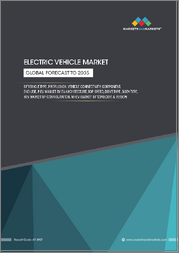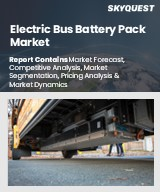
|
시장보고서
상품코드
1773292
인도의 EV 시장(2024-2031년)Electric Vehicle Market, India, 2024-2031 |
||||||
제조 현지화, 혁신, 규모의 경제가 향후 2-5년간 혁신적 성장을 견인
인도는 전기 사륜차 보급이 점차 확대되고 있으며, 세계 기업의 주요 시장으로 부상하고 있습니다. 인도 전기자동차 시장의 성장은 주로 제조 현지화, 공급망 안전성, 수출 경쟁력, 환경 의식에 중점을 둔 정부의 노력과 인센티브에 의해 이루어지고 있습니다. 증가하는 수요에 대응하기 위해 세계 기업 및 국내 기업들은 인도 시장에 새로운 전기자동차 모델을 출시하고 있습니다. 이는 충전 인프라 제공업체와 배터리 기술 기업들에게 큰 비즈니스 기회를 제공할 뿐만 아니라, 혁신적인 금융 비즈니스 모델 창출, 현지 전기자동차 부품 제조 역량 강화, 공공 및 민간 기업의 차량 전동화 촉진으로 이어질 수 있습니다.
이번 조사의 주제는 다음과 같습니다:
- 인도 전기자동차 시장에 영향을 미치는 산업 동향
- 지역별/주별 전기자동차 보급률
- 주요 OEM의 전기자동차 판매 기여
- OEM 생산 인프라, 투자, 시장 개발 접근 방식
- 인도 전기자동차 시장의 향후 전망
목차
조사 범위
- 인도 EV 시장 : 개요
- 지역 세분화
인도 전기자동차 시장의 변화
- 왜 성장이 어려워지는가?
- The Strategic Imperative 8
- 인도 전기자동차 시장에 미치는 3대 전략적 과제의 영향력
생태계
- 조사 방법
- 설문조사를 통해 답변하는 질문
- 경쟁 환경
- 주요 경쟁사
- EV OEM에 영향을 미치는 요인
- EV 유통 채널
성장 제너레이터
- 주요 조사 결과 : 현재와 향후 전망
- 주요 성장 지표
- 성장 촉진요인
- 성장 억제요인
- 시장 성장에 영향을 미치는 잠재적 트렌드
- 공급망 지역화
- 상호 운용 가능한 충전 네트워크
- 주요 전략적 제휴
- 커넥티드 기능
- UX IoT : 양산형 EV의 프리미엄 기능
- 배터리 기술의 발전
- 인도의 인센티브 진화
- 타임라인 : 주요 제도와 인센티브
- 주요 국가의 구매 보조금/면제 제도
- 미국의 새로운 관세가 인도 전기자동차 산업에 미치는 영향
- 예측에 대한 인사이트
- 인도 전기자동차 시장(2024년)과 2025e
- EV 보급률, 지역별 : 2024년 비교 요약
- 인도 : 전기자동차 판매 전망
- EV 판매 예측, 지역별
- EV 판매량 점유율 및 시장 점유율, OEM별, 2024년
북부 지역 EV 시장 : 개요
- 주요 성장 지표
- 지역 개요 : 북부 지역
북동부 지역 EV 시장 : 개요
- 주요 성장 지표
- 지역 개요 : 북동부 지역
동부 지역 EV 시장 : 개요
- 주요 성장 지표
- 지역 개요 : 동부 지역
중부 지역 EV 시장 : 개요
- 주요 성장 지표
- 지역 개요 : 중부 지역
서부 지역 EV 시장 : 개요
- 주요 성장 지표
- 지역 개요 : 서부 지역
남부 지역 EV 시장 : 개요
- 주요 성장 지표
- 지역 개요 : 남부 지역
경쟁 상황
- 사업 OEM 투자/이니셔티브
- 인도의 주요 EV 생산 시설 : 요약
- 인도의 1차 PV 생산능력 : 요약
- 주요 EV 개발 지역 클러스터
- EV 개발 주요 지역 : 채용 현황
- 배터리 셀 생산 전망, 주요 진출 기업별
- 타임라인 : OEM의 전략적 초점
주요 기여자 : 전시
- Tata Motors
- JSW MG Motors India
- Mahindra & Mahindra
성장기회 유니버스
- 성장 기회 1 : EV 산업의 자급자족을 촉진하는 정부의 노력
- 성장 기회 2 : 현지화 실현
- 성장 기회 3 : 국내 협력
주요 결론
- 3대 결론
부록 및 다음 단계
- 성장 기회의 혜택과 영향
- 다음 단계
- 자료 목록
- 면책사항
Manufacturing Localization, Innovation, and Economies of Scale will Drive Transformational Growth in the Next 2-5 Years
The adoption of electric four-wheelers in India is growing gradually, making it a major market for global companies. The growth of the electric vehicle (EV) market in the country is predominantly driven by government initiatives and incentives, mainly focusing on manufacturing localization, supply chain security, and export competitiveness, as well as environmental awareness. To keep up with the growing demand, global and domestic companies are on the verge of launching new EV models in the Indian market, which will not only open significant opportunities for charging infrastructure providers and battery technology companies but also pave the way for innovative financing business models, enhancing local EV component manufacturing capability and encouraging private and public companies to electrify their fleets; for example, last-mile delivery service companies shifting to EVs will see a significant spike.
This study covers the following topics:
- Industry trends impacting the Indian EV market
- EV adoption by regions/states
- EV sales contributions by primary OEMs
- OEMs' production infrastructure, investments, and market development approach
- Future outlook for the Indian EV market
The Impact of the Top 3 Strategic Imperatives on the Indian EV Market
Competitive Intensity
Transformative Megatrends
Industry Convergence
Why
- Presently, domestic and offshore OEM brands dominate the Indian electric PV market by securing the top 2 positions in the sales chart.
- These OEMs primarily focus on compact SUVs and hatchbacks to attract urban consumers in India's metropolitan areas.
Frost Perspective
- India's EV industry is poised for heightened competition in the coming years as more OEMs enter the market.
- Notably, the entry of established companies such as Maruti, backed by a vast customer base and strong scalability, will not only boost EV sales but also enhance consumer confidence in EVs. Maruti is expected to launch at least 4 EVs in India over the next 5 years.
Why
- As major Indian cities such as Delhi, Bengaluru, and Mumbai struggle with severe air quality issues, the electrification of urban mobility has become a crucial initiative to successfully tackle pollution challenges.
Frost Perspective
- Alongside consumers adopting EVs due to advantages related to operating and maintenance costs, the transition of fleet owners to EVs will significantly contribute to addressing air quality issues in major cities.
- Nevertheless, chasing infrastructure expansion by public and private networks will play a crucial role in realizing change in urban mobility.
Why
- Indian companies are collaborating with global technology and battery firms; for example, market leader Tata is partnering with Renesas (a Japanese chip maker) to develop an EV ecosystem in India with a focus on semiconductor solutions and EV-specific technology.
Frost Perspective
- These global partnerships, along with local production investments, reduce dependency on imports and lower production costs.
- Apart from this, these alliances combine international technology and investment with local market understanding and policy incentives to create a high-impact model for scaling EV adoption.
Competitive Environment
- Number of Competitors the Study Considers
- 14 (Tata Motors, JSW MG Motors India, Mahindra & Mahindra, BYD India, PCA India (Citroen), BMW India, Mercedes-Benz, Hyundai Motor India, Volvo Auto India, Kia India, Audi, Porsche, Rolls-Royce, JLR India)
Competitive Factors
- EV unit sales
Top 5 Competitors
- Tata Motors, JSW MG Motors India, Mahindra & Mahindra, BYD India, PCA India (Citroen)
Market Share of the Top 3 OEMs
- 91.1% (Tata Motors, JSW MG Motors India, Mahindra & Mahindra)
Other Notable Competitors
- BMW India, Mercedes-Benz, Hyundai Motor India, Volvo Auto India, Kia India
Scope
Market Analysis
- Comprehensive evaluation of market trends.
Competitive Landscape
- Overview of key players in the Electric Vehicle Market, India.
Regulatory Framework
- Insights on policies affecting the electric vehicle sector.
Consumer Insights
- Understanding consumer behavior and adoption trends.
Technological Advancements
- Examination of innovations driving the market forward.
Table of Contents
Research Scope
- The Indian EV Market: Overview
- Regional Segmentation
Transformation in the Indian EV Market
- Why is it Increasingly Difficult to Grow?
- The Strategic Imperative 8
- The Impact of the Top 3 Strategic Imperatives on the Indian EV Market
Ecosystem
- Research Methodology
- Questions This Study Will Answer
- Competitive Environment
- Key Competitors
- Factors Influencing EV OEMs
- EV Distribution Channels
Growth Generator
- Primary Findings: Current and Future Outlook
- Key Growth Metrics
- Growth Drivers
- Growth Restraints
- Potential Trends Influencing Market Growth
- Supply Chain Localization
- Interoperable Charging Networks
- Key Strategic Collaborations
- Connected Features
- UX IoT: Premium Features in Mass EVs
- Battery Technology Advancements
- Incentive Evolution In India
- Timeline: Major Schemes and Incentives
- Purchase Subsidies/Exemptions by Leading States
- Impact of New US Tariffs on the Indian EV Industry
- Forecast Considerations
- Indian EV Market: 2024 and 2025e
- EV Adoption by Region: 2024 Comparison Summary
- India: EV Sales Forecast
- EV Sales Forecast by Region
- EV Unit Sales Share and Market Share by OEMs, 2024
Northern Region EV Market: Overview
- Key Growth Metrics
- Regional Overview: Northern Region
Northeastern Region EV Market: Overview
- Key Growth Metrics
- Regional Overview: Northeastern Region
Eastern Region EV Market: Overview
- Key Growth Metrics
- Regional Overview: Eastern Region
Central Region EV Market: Overview
- Key Growth Metrics
- Regional Overview: Central Region
Western Region EV Market: Overview
- Key Growth Metrics
- Regional Overview: Western Region
Southern Region EV Market: Overview
- Key Growth Metrics
- Regional Overview: Southern Region
Competitive Landscape
- Operating OEMs' Investments/Initiatives
- Key EV Production Facilities in India: Summary
- Primary Electric PV Production Capability in India: Summary
- Key EV Development Regional Clusters
- EV Developments Key Areas: Adoption Status
- Battery Cell Production Outlook by Key Participants
- Timeline: OEMs' Strategic Focus
Key Contributors: Exhibits
- Tata Motors
- JSW MG Motors India
- Mahindra & Mahindra
Growth Opportunity Universe
- Growth Opportunity 1: Government Initiatives Pushing the EV Industry Toward Self-sufficiency
- Growth Opportunity 2: Enabling Localization
- Growth Opportunity 3: Domestic Collaboration
Key Conclusions
- Top 3 Conclusions
Appendix & Next Steps
- Benefits and Impacts of Growth Opportunities
- Next Steps
- List of Exhibits
- Legal Disclaimer



















